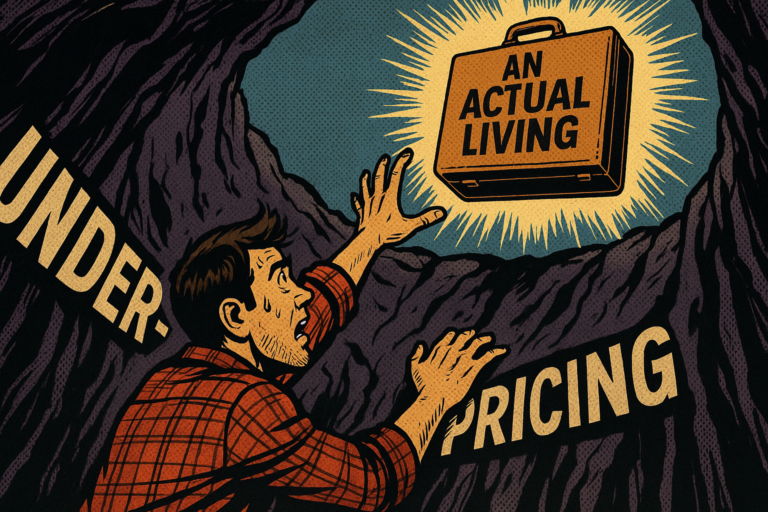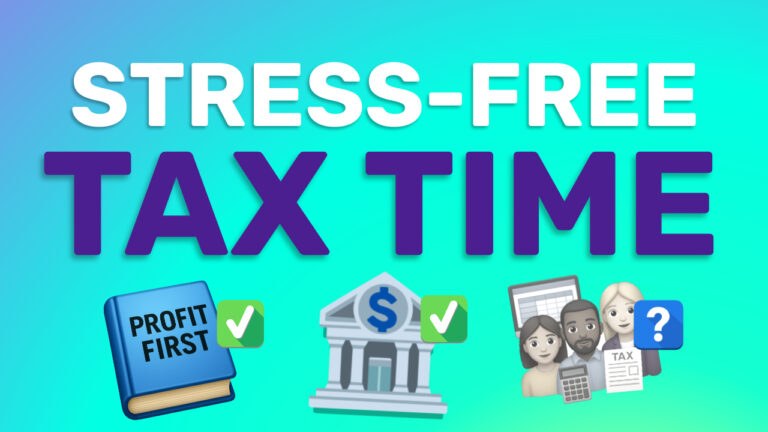I’m going to teach you a financial framework that guarantees profitability for your business — from day one. You work hard for your business. Stop paying yourself table scraps that are left over after all of your business expenses. Let’s talk about Profit First.
I’m going to do a quick rundown of the Profit First method popularized by Mike Michalowicz, who some people call the “patron Saint of entrepreneurs.” If you haven’t picked up any of his books, do that right now.
In an earlier video, I recommended that all businesses have two business bank accounts separate from their personal finances: one for business income and expenses to make sure that you’re not mingling your personal monies with your business money, and then a separate account to make sure that you’re not spending what belongs to the government. And you have that on hand to pay during tax time. Profit First takes it to the next level and recommends you open five business bank accounts one for income, one for profit, one for tax, one for your owner’s pay, and one for operating expenses. I’ll show you how this breaks down.
All of your money goes into the income account, and then you divvy this up into your other accounts:
Profit first.
Pull out 1%. Start with 1%. Maybe work it up to 3%
I currently am pulling out 5% of each paycheck into my profit account. I’m going to tell you what I do with that in just a second. But you set that aside. You are profitable. Now, no matter what happens, you have money in the bank.
Tax
You need to push that to the side. Hold that. Make sure that you’re not going to get stuck with a tax bill that you don’t have money to pay.
Owners pay
Your business should be paying you.
This is why you do it. You don’t do it just to grow a big business so you can starve. Grow yourself before you grow your business.
Operating expenses
We’re putting this on the bottom because instead of profit and owners pay being whatever leftover after operating expenses, we’re going to flip that. This is derived from Parkinson’s law, which States if you have more resources, you’re going to use more resources.
Parkinson’s first law talks about time. I’m paraphrasing, but basically, if you have more time to get a project done, you’re going to procrastinate and you’re going to take more time to get a project done. But if you give yourself a deadline, you’re going to be a lot more productive in a smaller window of time.
Mike Michalowicz talks about a toothpaste tube. If you get a new tube of toothpaste, you’re squeezing that thing like it’s a Go-gurt. But when it runs out, you are going to get creative. You’re going to do everything you can to squeeze the last little bit of toothpaste out of that tube. You don’t want to waste any of it. Scarcity of resources generates creativity and motivates you to exert a little bit more effort to extract as much value from your resources as possible. So Profit First is more than just a nice budgeting tool. It actually helps you get more creative with your business money.
If I only allow myself to spend 15% of every paycheck on operating expenses, that’s going to rein me in from throwing money on new tools and software that I honestly probably won’t ever use. It’s going to make me a lot more discriminating when I think about how I spend that money.
Now, this is going to look different for your specific situation. If you work with physical products, you’re going to have a little bit more overhead. If you ship them, all of these expenses are going to winnow down your income a little bit more. But if your net revenue is lower, your taxes are going to be lower, so you can safely set aside a lower portion of your paycheck for taxes. Like I said, it’s all based on your situation.
So that’s the of Profit First. Let’s talk about the .
Mike recommends opening up five different checking accounts for each of these buckets. I will say that’s probably the cleanest way of doing this, and that’s how I started with Profit First. But I have found there are some other tools you could leverage. Novo bank has a nice feature called Reserves, which allows you to create envelopes within a single bank account where you can set money aside for taxes and any other goals you might have. That’s nice because sometimes it’s hard to find a bank account that’s going to work with this.
Sometimes banks require you to hold a minimum balance in your account or else you have to pay fees on it. And that’s problematic because your income account is going to be emptied down to $0 twice a month. But there are some banks that do play nice. NBKC is one that I’ve used before and works well with this. You can also check with your local community bank or credit union. (Updated recommendation: I love Relay Financial)
Whichever bank you choose, make sure they don’t have a minimum deposit amount or balance amount or other requirements you need to meet in order to avoid paying fees on these accounts, because some of them are going to be sitting pretty inactive.
Now you set up your five different accounts. Every time you get paid deposit the full amount of your paycheck into your income account. Now, don’t worry. You don’t have to be constantly moving money around.
Maybe just twice or even once a month. You can go into your bank account and divvy up your income into your sub accounts. So let’s say we’re starting with 1% profit. If you have $1,000 in your income account, take $10 and put that in profit still going to tell you what we’re going to do with that in just a minute. Take the percentage that you’re going to hold for tax and put that into your tax account.
Take the percentage that you’re going to put into owner’s pay. Put that into the owner’s pay account, and take the percentage that you’ve determined is a good operating expense for you and put that into your OpEx account. See if your bank allows you to name your accounts so you can easily see the purpose and allocation for each account. That’s a nice little trick that makes life a little bit easier.
Now you’ve divvied up your income into these different accounts. Your operating expenses can just sit there. Your business credit card and any other accounts that you have to pay on regularly should be synced up to your operating expense account, not your income account (because, remember, when it comes time to pay your credit card bills, the income account might be sitting at zero, depending on the time of month).
Write a check or transfer your money out for your owners pay when it comes time to give yourself a paycheck.
Taxes can just sit there until you pay them out once a quarter. Or if you need an extra layer of security and self control, you can transfer that out to a separate bank account. So now we’re up from five accounts to six. But this might be good for a couple of reasons. You only have to pay your taxes quarterly. So instead of having a big chunk of money just sitting in an account that probably doesn’t yield any interest at all, you could transfer this into a high yield savings account. So you get a little something, while it’s also out of sight, out of mind. If you don’t have a lot of self control, you might want to remove the temptation and put that somewhere else where you’re not going to think, “Oh, I’m in a pinch. I can just transfer the tax money out easily into my operating expenses” or, “Oh, I can transfer that into my owner’s pay and treat myself.” Remember, this is the government’s money, so don’t touch it.
Now, we’ve been using the word “profit” a lot, and we’ve created this “profit” account. What do we actually do with that?
Once a quarter, you treat yourself.
Actually, you take 50% of whatever is in your profit account and you distribute it to all of the shareholders. If you’re the only owner of your business, it all goes to you. If you have a partner, split that in half and distributed accordingly. But this is treat yourself money.
Have fun with it. Put it towards your vacation fund or take your wife out for a nice dinner. This is your reward for working hard on your business. It’s guilt free money.
It’s a small percentage that you’ve set aside, and now you get to enjoy the fruits of your labor. This is more important than you might realize because it’s so easy to get wrapped up in the grind of running your own business. It’s so easy to feel beholden to keeping your business afloat, which you are. But if every ounce of you and every dollar is going back into your business, you’re going to run out of energy. You’re going to run out of motivation.
So every three months, take whatever little bit of money is in your profit account or whatever lot of bit of money is in your profit account and do something fun with it. Yeah, you know what? I’m going to do that. I’m going to treat myself. The other 50% you can put in the vault yet another account.
This is money that you’re setting aside for a rainy day for your business. In case, say, another pandemic hits and you need to pull money from somewhere to help you make it to the next month. You have it in the vault, or if there is a large planned expense that you’d like to reinvest some money back into your business. Maybe it’s a conference or professional development thing or some capital equipment. Your vault money is there, and you can reinvest that back into your business.
But really, I’ll leave it up to you. These are just recommendations that one person made and one business book. And I am kind of re-upping these recommendations because I think they’re good. But rules are meant to be broken. Sometimes you can adapt this to however it best suits your specific situation.
I’d caution you about breaking too many rules. I really think divvying up your income into distinct buckets works really well. It’s great practice for your personal finances as well. Dave Ramsey Love or hate him, I like what he says about giving every dollar a job. In the case of Profit First, some of your daughter’s jobs is to dance around and have a good time.
So I highly recommend picking up a copy of Profit First by Mike Michalowicz. Dig into it. He goes into a lot more detail about how to get this set up and get started. I think it’s great stuff. I’ll leave a link to the book below in the description, along with some banks I know work well with the system.
If you have any questions, drop a line below in the comments. If you’ve implemented Profit First for your business, let me know how it’s working out for you. And don’t get greedy. Don’t keep this information to yourself. Be sure to hit the like button so the YouTube algorithm knows to pump this out to even more entrepreneurs and business owners and more people can enjoy businesses success and be sure to hit subscribe because I’m just getting started.


